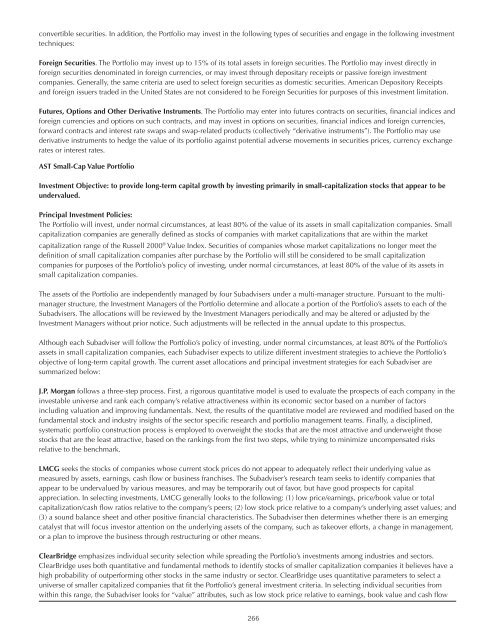Advanced Series Trust AST Academic Strategies Asset ... - Prudential
Advanced Series Trust AST Academic Strategies Asset ... - Prudential
Advanced Series Trust AST Academic Strategies Asset ... - Prudential
You also want an ePaper? Increase the reach of your titles
YUMPU automatically turns print PDFs into web optimized ePapers that Google loves.
convertible securities. In addition, the Portfolio may invest in the following types of securities and engage in the following investment<br />
techniques:<br />
Foreign Securities. The Portfolio may invest up to 15% of its total assets in foreign securities. The Portfolio may invest directly in<br />
foreign securities denominated in foreign currencies, or may invest through depositary receipts or passive foreign investment<br />
companies. Generally, the same criteria are used to select foreign securities as domestic securities. American Depository Receipts<br />
and foreign issuers traded in the United States are not considered to be Foreign Securities for purposes of this investment limitation.<br />
Futures, Options and Other Derivative Instruments. The Portfolio may enter into futures contracts on securities, financial indices and<br />
foreign currencies and options on such contracts, and may invest in options on securities, financial indices and foreign currencies,<br />
forward contracts and interest rate swaps and swap-related products (collectively “derivative instruments”). The Portfolio may use<br />
derivative instruments to hedge the value of its portfolio against potential adverse movements in securities prices, currency exchange<br />
rates or interest rates.<br />
<strong>AST</strong> Small-Cap Value Portfolio<br />
Investment Objective: to provide long-term capital growth by investing primarily in small-capitalization stocks that appear to be<br />
undervalued.<br />
Principal Investment Policies:<br />
The Portfolio will invest, under normal circumstances, at least 80% of the value of its assets in small capitalization companies. Small<br />
capitalization companies are generally defined as stocks of companies with market capitalizations that are within the market<br />
capitalization range of the Russell 2000 ® Value Index. Securities of companies whose market capitalizations no longer meet the<br />
definition of small capitalization companies after purchase by the Portfolio will still be considered to be small capitalization<br />
companies for purposes of the Portfolio’s policy of investing, under normal circumstances, at least 80% of the value of its assets in<br />
small capitalization companies.<br />
The assets of the Portfolio are independently managed by four Subadvisers under a multi-manager structure. Pursuant to the multimanager<br />
structure, the Investment Managers of the Portfolio determine and allocate a portion of the Portfolio’s assets to each of the<br />
Subadvisers. The allocations will be reviewed by the Investment Managers periodically and may be altered or adjusted by the<br />
Investment Managers without prior notice. Such adjustments will be reflected in the annual update to this prospectus.<br />
Although each Subadviser will follow the Portfolio’s policy of investing, under normal circumstances, at least 80% of the Portfolio’s<br />
assets in small capitalization companies, each Subadviser expects to utilize different investment strategies to achieve the Portfolio’s<br />
objective of long-term capital growth. The current asset allocations and principal investment strategies for each Subadviser are<br />
summarized below:<br />
J.P. Morgan follows a three-step process. First, a rigorous quantitative model is used to evaluate the prospects of each company in the<br />
investable universe and rank each company’s relative attractiveness within its economic sector based on a number of factors<br />
including valuation and improving fundamentals. Next, the results of the quantitative model are reviewed and modified based on the<br />
fundamental stock and industry insights of the sector specific research and portfolio management teams. Finally, a disciplined,<br />
systematic portfolio construction process is employed to overweight the stocks that are the most attractive and underweight those<br />
stocks that are the least attractive, based on the rankings from the first two steps, while trying to minimize uncompensated risks<br />
relative to the benchmark.<br />
LMCG seeks the stocks of companies whose current stock prices do not appear to adequately reflect their underlying value as<br />
measured by assets, earnings, cash flow or business franchises. The Subadviser’s research team seeks to identify companies that<br />
appear to be undervalued by various measures, and may be temporarily out of favor, but have good prospects for capital<br />
appreciation. In selecting investments, LMCG generally looks to the following: (1) low price/earnings, price/book value or total<br />
capitalization/cash flow ratios relative to the company’s peers; (2) low stock price relative to a company’s underlying asset values; and<br />
(3) a sound balance sheet and other positive financial characteristics. The Subadviser then determines whether there is an emerging<br />
catalyst that will focus investor attention on the underlying assets of the company, such as takeover efforts, a change in management,<br />
or a plan to improve the business through restructuring or other means.<br />
ClearBridge emphasizes individual security selection while spreading the Portfolio’s investments among industries and sectors.<br />
ClearBridge uses both quantitative and fundamental methods to identify stocks of smaller capitalization companies it believes have a<br />
high probability of outperforming other stocks in the same industry or sector. ClearBridge uses quantitative parameters to select a<br />
universe of smaller capitalized companies that fit the Portfolio’s general investment criteria. In selecting individual securities from<br />
within this range, the Subadviser looks for “value” attributes, such as low stock price relative to earnings, book value and cash flow<br />
266

















